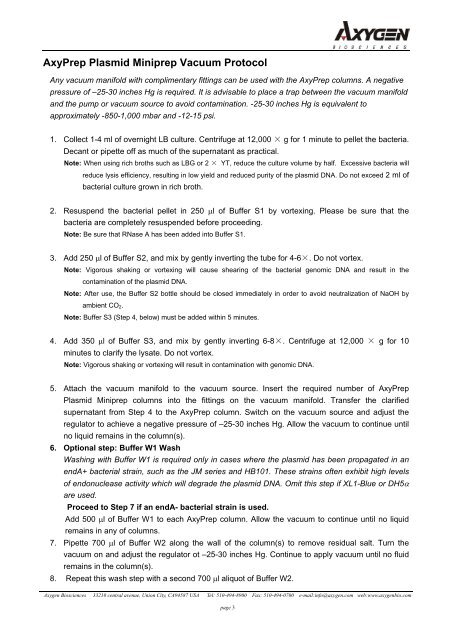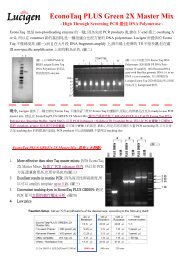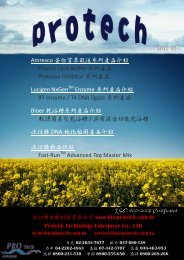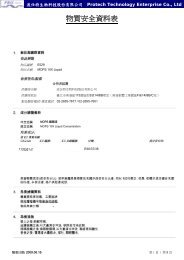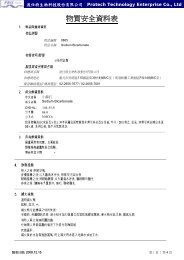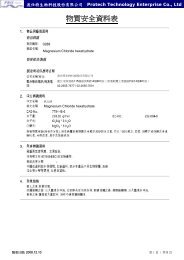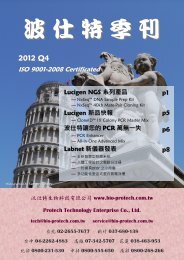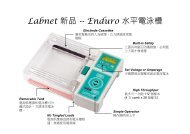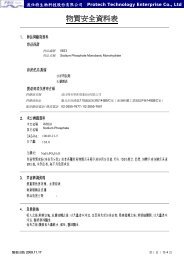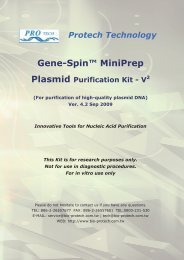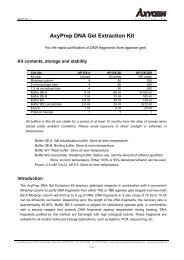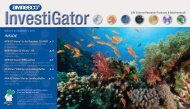AxyPrep Plasmid Miniprep Kit
AxyPrep Plasmid Miniprep Kit
AxyPrep Plasmid Miniprep Kit
Create successful ePaper yourself
Turn your PDF publications into a flip-book with our unique Google optimized e-Paper software.
<strong>AxyPrep</strong> <strong>Plasmid</strong> <strong>Miniprep</strong> Vacuum ProtocolAny vacuum manifold with complimentary fittings can be used with the <strong>AxyPrep</strong> columns. A negativepressure of –25-30 inches Hg is required. It is advisable to place a trap between the vacuum manifoldand the pump or vacuum source to avoid contamination. -25-30 inches Hg is equivalent toapproximately -850-1,000 mbar and -12-15 psi.1. Collect 1-4 ml of overnight LB culture. Centrifuge at 12,000 × g for 1 minute to pellet the bacteria.Decant or pipette off as much of the supernatant as practical.Note: When using rich broths such as LBG or 2 × YT, reduce the culture volume by half. Excessive bacteria willreduce lysis efficiency, resulting in low yield and reduced purity of the plasmid DNA. Do not exceed 2 ml ofbacterial culture grown in rich broth.2. Resuspend the bacterial pellet in 250 μl of Buffer S1 by vortexing. Please be sure that thebacteria are completely resuspended before proceeding.Note: Be sure that RNase A has been added into Buffer S1.3. Add 250 μl of Buffer S2, and mix by gently inverting the tube for 4-6×. Do not vortex.Note: Vigorous shaking or vortexing will cause shearing of the bacterial genomic DNA and result in thecontamination of the plasmid DNA.Note: After use, the Buffer S2 bottle should be closed immediately in order to avoid neutralization of NaOH byambient CO 2 .Note: Buffer S3 (Step 4, below) must be added within 5 minutes.4. Add 350 μl of Buffer S3, and mix by gently inverting 6-8×. Centrifuge at 12,000 × g for 10minutes to clarify the lysate. Do not vortex.Note: Vigorous shaking or vortexing will result in contamination with genomic DNA.5. Attach the vacuum manifold to the vacuum source. Insert the required number of <strong>AxyPrep</strong><strong>Plasmid</strong> <strong>Miniprep</strong> columns into the fittings on the vacuum manifold. Transfer the clarifiedsupernatant from Step 4 to the <strong>AxyPrep</strong> column. Switch on the vacuum source and adjust theregulator to achieve a negative pressure of –25-30 inches Hg. Allow the vacuum to continue untilno liquid remains in the column(s).6. Optional step: Buffer W1 WashWashing with Buffer W1 is required only in cases where the plasmid has been propagated in anendA+ bacterial strain, such as the JM series and HB101. These strains often exhibit high levelsof endonuclease activity which will degrade the plasmid DNA. Omit this step if XL1-Blue or DH5αare used.Proceed to Step 7 if an endA- bacterial strain is used.Add 500 μl of Buffer W1 to each <strong>AxyPrep</strong> column. Allow the vacuum to continue until no liquidremains in any of columns.7. Pipette 700 μl of Buffer W2 along the wall of the column(s) to remove residual salt. Turn thevacuum on and adjust the regulator ot –25-30 inches Hg. Continue to apply vacuum until no fluidremains in the column(s).8. Repeat this wash step with a second 700 μl aliquot of Buffer W2.Axygen Biosciences 33210 central avenue, Union City, CA94587 USA Tel: 510-494-8900 Fax: 510-494-0700 e-mail:info@axygen.com web:www.axygenbio.compage 3


